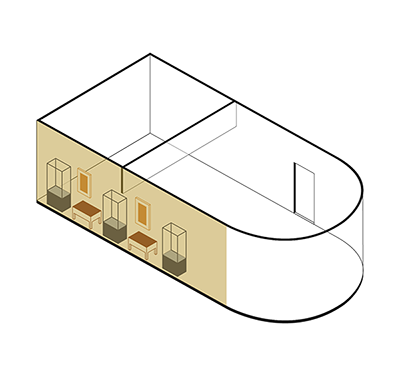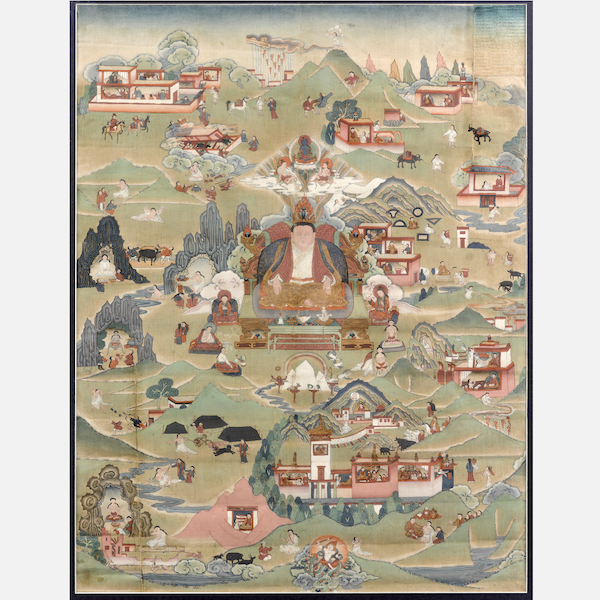
ABP 033
Code: ABP 033
Country: Tibet (east)
Style:
Date: 1800
Dimensions in cm WxHxD: 50 x 65
Materials: Glue distemper on cotton
Milarepa(1040 - 1123)
Milarepa, the most renowned yogi in Tibetan history. He was born in Gungthang. His father was Mila Sherap Gyaltsen and mother, Nyangtsa Kargyen. He had one younger sister, Peta Paldron. He was named Mila Thöpaga, which means "Mila who is a joy to hear." At a young age, he lost his father and his family's estate passed into the hands of his father's brother, Mila Thöpaga's uncle, who, with his wife, virtually enslaved Mila's mother and family, making them work in the field. He, along with his mother and sister, went through tremendous suffering because of the ill treatment of his uncle and aunt.
A Foray Into Magic
At his mother's request, when Mila grew up, he studied magic from two different teachers in order to take revenge through the use of magical powers. Through a spell, he killed thirty-seven people, including his uncle's family, and destroyed most of the crops of the village. After this was done, great remorse arose in him for the heavy karmic consequences he had caused himself, and his mind turned towards the sacred dharma.
Mila first went to the Tsang region and studied with the great master, Rongtön Lhaga. The latter eventually advised Mila to go and study with Marpa. At the age of thirty-eight, he went to Lhodrak to find Marpa. Before he arrived, Marpa had a dream in which a yidam prophesied the arrival of Milarepa.
Studies Under Marpa
Mila spent over six years studying with Marpa, who made Mila build the famous nine-story tower as part of his journey on the path. At the end, he received the abhisheka of Chakrasamvara from Marpa during which he received the secret name, Shepa Dorje, which means "Laughing Vajra." Marpa also conferred on Milarepa the full transmissions, instructions, and abhishekas of Tantra, as well as the lineage of Mahamudra - all that Marpa had received from Indian mahasiddhas Naropa and Maitripa.
Enlightenment and Teaching Through Poetic Songs
After practicing very diligently for twelve years under Lord Marpa, Milarepa attained the inseparable state of vajradhara (the complete state of enlightenment) in this very lifetime. He then became known as Milarepa, which means the "Mila, the cotton clad one." ("Repa" is the designation given to many tantric yogins since they wear a white robe.) At the age of forty-five, he started to practice at Drakar Taso (White Rock Horse Tooth), and other well-known caves and also began to wander and teach at various places.
Milarepa is most famous for his songs and poems, in which he expresses the profundity of his realization of the dharma with extraordinary clarity and beauty. Many of Milarepa's poetic compositions have been translated into numerous other languages.
Milarepa had countless disciples such as Rechung Dorje Drakpa, Gampopa or Dhakpo Lhaje, the eight-heart-sons, and many others. Among them, his spiritual successor who continued his lineage and became one of the main lineage masters in Milarepa's tradition was Gampopa.
Bachhofer, Joss, 1986. Verrückte Weisheit: Leben und Lehre Milarepas. Haldenwang: Edition Schangrila.
Béguin, Gilles, 2013. Art sacré du Tibet – Collection Alain Bordier, [catalogue of the exhibition held at the Fondation Pierre Bergé – Yves Saint Laurent; 14 mars au 21 juillet 2013]. Paris: Fondation Pierre Bergé – Yves Saint Laurent. Editions Findakli.
Bock, Etienne; Falcombello, Jean-Marc; Jenny Magali, 2022. Trésors du Tibet. Sur les pas de Milarépa.. Paris: Flammarion. Pp. 236-241
Chang, Garma C.C. , 2010. The Hundread thousand Songs of Milarepa. Kessinger Publishing.
Cornu, Philippe , 2001. Dictionnaire Encyclopédique du Bouddhisme. Seuil. P. 367
Evan-Wentz, Walter Yeeling, 1985. Milarepa - Tibets Grosser Yogi. München: Otto Wilhelm Barth.
Evan-Wentz, Walter Yeeling, 2000. Tibet's Great Yogi Milarepa - A Biography from the Tibetan being the JetsünKahbum. London: Oxford University Press.
Laufer, Berthold, 1922. Milaraspa: Tibetische Texte in Auswahl. Hagen i.W. Folkwang Verlag.
Schmid, Toni, 1952. The Cotton-Clad Mila: The Tibetan Poet-Saint's Life in Pictures. Stockholm: The Sven Hedin Foundation; Statens Ethnografiska Museum.

